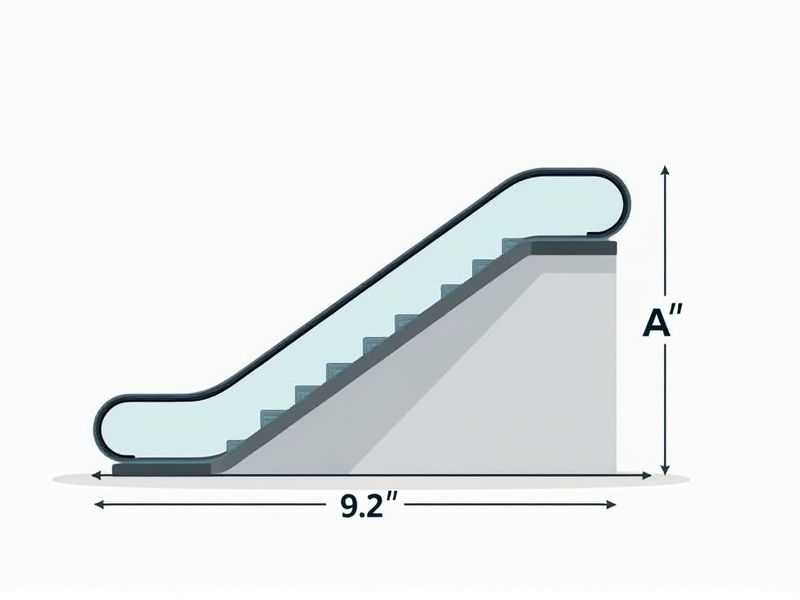
When planning for the installation of an escalator, it's important to know the standard dimensions to ensure a proper fit and safe operation. Typically, the standard width of an escalator step is 600 mm, 800 mm, or 1000 mm, with 1000 mm being most common in high-traffic public spaces. The rise (vertical height covered) can range from a few meters up to around 20 meters, while the angle of inclination is commonly set at 30 degrees, though some models allow for a 35-degree incline in tighter spaces. Always consult local regulations, as both building codes and manufacturer recommendations may influence the specific dimensions required for your project.
Tread Width
The standard tread width for escalators generally measures between 16 to 20 inches, ensuring passenger safety and comfort during transit. This dimension helps facilitate a smooth flow of foot traffic, with a typical escalator capable of accommodating over 6,000 passengers per hour. Ensuring that your escalator adheres to these guidelines can significantly reduce accidents and improve user experience. Moreover, maintaining the appropriate tread width is essential in compliance with building codes and safety regulations specific to escalator installations.
Step Depth
The standard for escalator step depth is critical for ensuring user safety and comfort, typically measuring around 16 inches (400 mm). This dimension is designed to provide a stable footing for users while boarding and alighting. Adhering to these specifications can help prevent accidents, such as trips and falls. Regular maintenance and inspections also contribute to the effectiveness of these standards, ensuring that steps remain in good condition and comply with safety regulations.
Inclination Angle
The standard inclination angle for escalators typically ranges between 30 to 35 degrees, ensuring both safety and efficiency in transit. An angle of 30 degrees is common in public settings, allowing users of varying heights and mobility to access the escalator comfortably. Compliance with these specifications is essential for preventing accidents and ensuring the smooth flow of pedestrian traffic. Regular inspections and adherence to safety regulations are crucial to maintain the functionality and reliability of escalators in various environments.
Riser Height
The standard riser height for escalators typically measures between 15 to 18 inches (38 to 46 cm), ensuring comfortable access for users. Maintaining this height range enhances safety and usability, particularly for individuals with varying mobility levels. Compliance with the Americans with Disabilities Act (ADA) guidelines emphasizes the need to adhere to these measurements, helping accommodate a diverse population. You should ensure that escalators in public spaces meet these standards to facilitate a smooth and safe flow of traffic.
Step Length
The standard step length for escalators typically ranges from 16 to 18 inches (40.6 to 45.7 cm), ensuring a comfortable and safe experience for users. This parameter is crucial for maintaining proper balance and minimizing the risk of accidents, particularly in crowded public spaces. Regular inspections are essential to ensure that the step length complies with safety regulations and provides a smooth ride. You should be aware that irregularities in step length can lead to user discomfort and increased liability for facilities.
Balustrade Height
The standard balustrade height for escalators is typically set between 900 mm (35 inches) and 1100 mm (43 inches), ensuring passenger safety and compliance with building codes. This height effectively prevents accidents and provides stability for users, particularly during high-traffic periods. In many jurisdictions, incorporating a continuous handrail at this height is also mandated, enhancing user support while ascending or descending. When designing your escalator, adhering to these dimensions not only meets legal requirements but also promotes a safer experience for all passengers.
Handrail Speed
The handrail speed of an escalator significantly impacts user safety and comfort, typically set at 0.3 to 0.4 meters per second. A synchronized handrail and stair movement ensures that passengers can maintain their balance while entering or exiting. If the handrail speed falls below the standard, it may lead to increased accidents, as users might misjudge the timing of their step. Adhering to these standards not only enhances the overall user experience but also aligns with safety regulations established by organizations such as ASME A17.1 and EN 115.
Horizontal Comb Surface
The standard for escalators emphasizes the importance of the horizontal comb surface, which is designed to provide a safe transition between the escalator steps and the landing area. This surface typically features a series of interlocking teeth that help prevent accidental foot entrapment, enhancing user safety. Compliance with safety regulations mandates that the comb surface must be of a specific height and depth, often measured in millimeters, to ensure optimal functionality. Regular maintenance and inspection of the comb surface are crucial to uphold these standards, ensuring a safe experience for users throughout the escalator's lifespan.
Vertical Truss Height
The standard for escalators specifies a vertical truss height typically ranging from 1.2 meters to 3 meters, depending on the installation context. This height ensures both safety and operational efficiency, accommodating passengers of diverse heights and mobility needs. Precise measurements must adhere to local regulations, which may dictate variations based on building design and usage purposes. Evaluating vertical truss height is essential for optimizing user accessibility and compliance with safety standards.
Landing Space
The standard for escalators significantly emphasizes the importance of landing space, which should ideally measure at least 1.5 meters in width to ensure safe and comfortable entry and exit. A minimum landing space depth of 1.0 meters is recommended to accommodate passenger flow and prevent congestion at the top and bottom of the escalator. The landing area must be designed to be free of obstructions, allowing users to step off easily and swiftly. Insufficient landing space can increase the risk of accidents, making adherence to these standards crucial for safety in public transport and commercial buildings.
